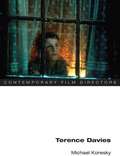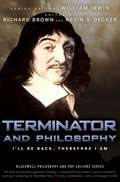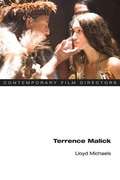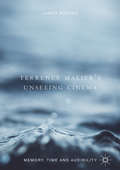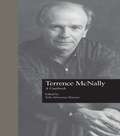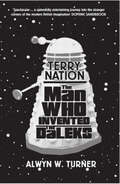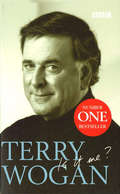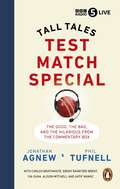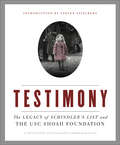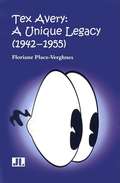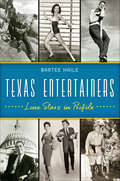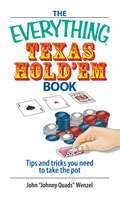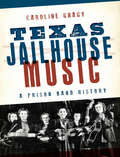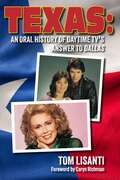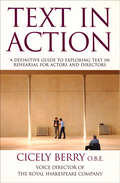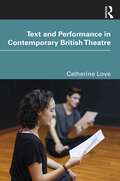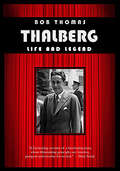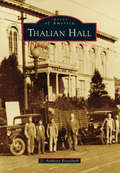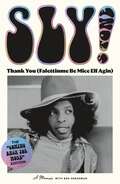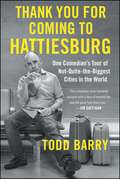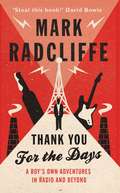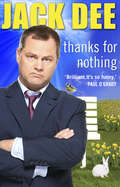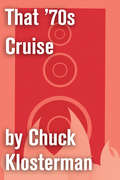- Table View
- List View
Terence Davies (Contemporary Film Directors)
by Michael KoreskyCalled the most important British filmmaker of his generation, Terence Davies made his reputation with modern classics like Distant Voices, Still Lives and The Long Day Closes, personal works exploring his fractured childhood in Liverpool. His idiosyncratic and unorthodox narrative films defy easy categorization; though they would seem to exist within the realms of realism and personal memory cinema, the films lay bare the director's personal pain in a daringly abstract way. Film critic Michael Koresky explores the unique emotional tenor of Davies' work by focusing on four paradoxes within the director's oeuvre: films that are autobiographical yet fictional; melancholy yet elating; conservative in tone and theme yet radically constructed; and obsessed with the passing of time yet frozen in time and space. Through these contradictions, the films' intricate designs reveal a cumulative, deeply personal meditation on the self. Koresky also analyzes how Davies' ongoing negotiation of--and struggle with--questions of identity related to his past and his homosexuality imbue the details and jarring juxtapositions in his films with a queer sensibility, which is too often overlooked due to the complexity of Davies' work and his unfashionable ambivalence toward his own sexual orientation.
Terminator and Philosophy: I'll Be Back, Therefore I Am
by Richard Brown Kevin S. DeckerTime travelers and battles between people and machines provoke old philosophical questions: Can the past really be changed? How do we differentiate ourselves from machines? Can machines have an inner life? Brown (philosophy critical thinking, LaGuardia Community Coll.) and Decker (philosophy, Eastern Washington Univ.; co-editor, Star Wars and Philosophy) collect 19 essays by primarily young academics who pursue these questions with entertaining verve and philosophical skill. The Terminator story is about something well intentioned, a defense project going wrong. Among the book's bright spots are contributions from Harry Chotiner and Jennifer Culver that show us something about how the movies work and explore the feminist issues posed by placing Sarah Connor at the center of the story. One essayist, Phillip Seng, addresses the philosophical trouble at the heart of the tale: telling good from evil in politics is hard.
Terrence Malick (Contemporary Film Directors)
by Lloyd MichaelsFor a director who has made only four feature films over three decades, Terrence Malick has sustained an extraordinary critical reputation as one of America's most original and independent filmmakers. In this book, Lloyd Michaels analyzes each of Malick's four features in depth, emphasizing both repetitive formal techniques such as voiceover and long lens cinematography as well as recurrent themes drawn from the director's academic training in modern philosophy and American literature. Michaels explores Malick's synthesis of the romance of mythic American experience and the aesthetics of European art film. He performs close cinematic analysis of paradigmatic moments in Malick's films: the billboard sequence in Badlands, the opening credits in Days of Heaven, the philosophical colloquies between Witt and Welsh in The Thin Red Line, and the epilogue in The New World. This richly detailed study also includes the only two published interviews with Malick, both in 1975 following the release of his first feature film.
Terrence Malick and the Examined Life (Intellectual History of the Modern Age)
by Martin WoessnerTerrence Malick is one of American cinema’s most celebrated filmmakers. His films—from Badlands (1973) and Days of Heaven (1978) to The Thin Red Line (1998), The Tree of Life (2011), and, most recently, A Hidden Life (2019)—have been heralded for their artistry and lauded for their beauty, but what really sets them apart is their ideas. Terrence Malick and the Examined Life is the most comprehensive account to date of this unparalleled filmmaker’s intellectual and artistic development.Utilizing newly available archival sources to offer original interpretations of his canonical films, Martin Woessner illuminates Malick’s early education in philosophy at Harvard and Oxford as well as his cinematic apprenticeship at the American Film Institute to show how a young student searching for personal meaning became a famous director of Hollywood films. Woessner’s book presents a rich, interdisciplinary exploration of the many texts, thinkers, and traditions that made this transformation possible—from the novels of Hamlin Garland, James Jones, and Walker Percy to the philosophies of Stanley Cavell, Martin Heidegger, and Søren Kierkegaard to road movies, Hollywood Westerns, and the comedies of Jean Renoir. Situating Malick’s filmmaking within recent intellectual and cultural history, Woessner highlights its lasting contributions to both American cinema and the life of the mind.Terrence Malick and the Examined Life suggests it is time for philosophy to be viewed not merely as an academic subject, overseen by experts, but also as a way of life, open to each and every moviegoer.
Terrence Malick’s Unseeing Cinema: Memory, Time And Audibility
by James BatchoThis unique study opens up a new dimension of Terrence Malick’s cinema – its expressions of unseeing and hearing. ‘Unseeing’ is Malick’s means of transcending the moment in order to enter the life that unfolds; to treat cinema as a real experience for those who live its reality. In this way, Terrence Malick’s Unseeing Cinema moves beyond film theory to advance a work of original philosophy, bringing together two thinkers not normally associated with one another: Gilles Deleuze and Søren Kierkegaard. It investigates how Malick’s gatherings of time allow one to explore new philosophical questions about immanence and transcendence, ethics and faith, time and infinity, and the foldings of subjectivity that are central to both philosophers. Beyond cinema, it offers a way to think about our everyday repetitions and recollections and our ephemeral points of connection with those we love.
Terrence McNally: A Casebook (Casebooks on Modern Dramatists #No. 22)
by Toby Silverman ZinmanFirst Published in 1997. Routledge is an imprint of Taylor & Francis, an informa company.
Terry Nation: The Man Who Invented the Daleks
by Alwyn W. TurnerA “splendidly entertaining” biography of the British tv writer acclaimed for his invention of a fictional alien race for Doctor Who (Dominic Sandrook, author of State of Emergency—The Way We Were: Britain 1970–1974).The Daleks are one of the most iconic and fearsome creations in television history. Since their first appearance in 1963, they have simultaneously fascinated and terrified generations of children, their instant success ensuring, and sometimes eclipsing, that of Doctor Who. They sprang from the imagination of Terry Nation, a failed stand-up comic who became one of the most prolific writers for television that Britain ever produced. Survivors, his vision of a post-apocalyptic England, so haunted audiences in the Seventies that the BBC revived it over thirty years on, and Blake’s 7, constantly rumored for return, endures as a cult sci-fi classic. But it is for his genocidal pepperpots that Nation is most often remembered, and now, more than 50 years after their creation they continue to top the Saturday-night ratings. Yet while the Daleks brought him notoriety and riches, Nation played a much wider role in British broadcasting’s golden age. He wrote for Spike Milligan, Frankie Howerd and an increasingly troubled Tony Hancock, and as one of the key figures behind the adventure series of the Sixties—including The Avengers, The Saint and The Persuaders!—he turned the pulp classics of his boyhood into a major British export. In The Man Who Invented the Daleks, acclaimed cultural historian Alwyn W. Turner, explores the curious and contested origins of Doctor Who’s greatest villains, and sheds light on a strange world of ambitious young writers, producers and performers without whom British culture today would look very different.
Terry Wogan - Is it me?
by Terry WoganTerry Wogan was one of Britain's best-loved radio and television celebrities witty, charming and relaxed and undoubtedly captured the nation's heart. Here, Terry tells his life story from his beginnings as a young Limerick boy to his incredible success as an enduring celebrity with shows such as Wogan and The Eurovision Song Contest. Is It Me? is written in Terry's own inimitable style, with self-deprecating humour and a wry take on everyday life. The story is a delightfully observed, light-hearted journey through Terry's personal and professional lives. After reluctantly starting his career in banking, Terry escaped to make a sucessful break into broadcasting with RTE. Fronting Children in Need, Wogan and The Eurovision Song Contest and collecting millions of listeners to his morning BBC 2 radio show, Wake Up To Wogan, he is now the most prolific and popular presenter at the BBC. 'I am sure it's a challenging read' Sir David Frost 'I don't remember him' Jimmy Young
Test Match Special: Tall Tales – The Good The Bad and The Hilarious from the Commentary Box
by Phil Tufnell Jonathan AgnewWho played the best pranks on his fellow team-mates? Which member of the TMS team terrorised his teachers in the annual staff-pupil game? And the truth behind 'the greatest sporting commentary of all time'...Between them, Jonathan Agnew and Phil Tufnell have probably watched more cricket than anyone alive, and they have many stories to tell, both as players and as commentators for Test Match Special. From their days as schoolboy cricketers, learning the ropes, to the shenanigans of the county circuit, and now their careers as commentators, they have seen it all.Joined by colleagues from TMS such as Isa Guha, Ebony Rainford Brent, Alison Mitchell, Carlos Brathwaite and Aatif Nawaz, Aggers and Tuffers share the highlights, mishaps and moments of brilliance and emotion that they have witnessed and experienced on pitches around the world.
Testimony: The Legacy of Schindler's List and the USC Shoah Foundation
by Steven SpielbergThis illustrated, large-format book, Testimony: The Legacy of Schindler’s List and the USC Shoah Foundation—A 20th Anniversary Commemoration combines, for the first time, the behind-the-scenes story of the making of Schindler’s List with the history of the remarkable organization inspired by that landmark film. Steven Spielberg’s encounters with Holocaust survivors who visited the set and personally told him their stories set him on a quest to collect and preserve survivor testimony for generations to come. In 1994, he established the Shoah Foundation, and in the following four years nearly 52,000 eyewitness interviews were video recorded in 56 countries and 32 languages. This commemorative book relates how the foundation accomplished this feat through a worldwide network of dedicated people, pioneering interview methods, and state-of-the art technologies.A special 140-page section tells the riveting story of the film in photos, script excerpts, and the words of the cast and crew, including Liam Neeson, Ben Kingsley, and Spielberg. Drawing from the Universal Pictures archives and exclusive interviews, here are details on Spielberg’s struggle to bring Oskar Schindler’s story from novel to script to screen, the casting, cinematography, and especially what happened during the difficult shoot in Poland in 1993—on locations where actual events of the Holocaust occurred. Partnered with the University of Southern California since 2006, the USC Shoah Foundation has broadened its mission and now collects and preserves testimonies from other genocides, including those in Armenia, Cambodia, and Rwanda, while expanding its educational outreach, especially to young people. Its Visual History Archive—digitized, fully searchable, and hyperlinked to the minute—has become the largest digital collection of its kind in the world. As Spielberg writes in his introduction, “I believe the work of the USC Shoah Foundation is the most important legacy of Schindler’s List.”
Tex Avery: A Unique Legacy
by Floriane Place-VerghnesFloriane Place-Verghnes examines the work of this great American animator. Focusing primarily on four facets of Avery's work, the author first concentrates on Avery's ability to depict the American attempt both to retrieve the past nostalgically and to catch the Zeitgeist of 1940s America, which confronts the questions of violence and survival. She also analyzes issues of sex and gender and the crucial role Hollywood played in reshaping the image of womanhood, reducing it to a bipolar opposition. Thirdly, she examines the comic language developed by Avery which, although drawing on the work of the Marx Brothers and Chaplin (among others), transcended their conventions. Finally, Place-Verghnes considers Avery's place in the history of cartoon-making technique.
Texas Entertainers: Lone Stars in Profile
by Bartee HaileIn keeping with its reputation for size and spectacle, Texas has produced a staggering number of stars. Although many hailed from towns too small to have a post office, they occupied the spotlight on the largest of stages. Roger Miller's songs made him the "King of the Road," and Howard Hughes stretched his vision across the skies of the silver screen. Gene Autry won fame as a singing cowboy and Van Cliburn wore a tuxedo to international piano competitions, but both hailed from the Lone Star State. Texans penned Old Yeller and voiced Daffy Duck. From Buddy Holly to Ginger Rogers and Joan Crawford to Jimmy Dean, Bartee Haile charts the brightest constellations of Texas entertainers.
Texas Hold 'Em Book (The Everything®)
by John WenzelBecome a Texas Hold’em champion!The Everything Texas Hold’em Book is your key to winning big! Written by expert gambler John “Johnny Quads” Wenzel, this all-inclusive book guides you through the game of Texas hold’em—from how to deal the first hand to how to take the pot home! Tips and tricks include how to: -Master your perfect poker face so your opponents have no clue about your hand -Bluff your way so smoothly that your opponents think they’ve got you figured out -Use the rules, assess the risks, and employ expert tactics to win big—in casinos or at your buddy’s house! Whether you’re new to the game or a veteran player, with The Everything Texas Hold’em Book you’ll see what the cards have in store for you!
Texas Jailhouse Music: A Prison Band History
by Caroline GnagyInside the Texas State Prison is a surprising story of ingenuity, optimism and musical creativity. During the mid-twentieth century, inmates at the Huntsville unit and neighboring Goree State Farm for Women captured hearts all over Texas during weekly radio broadcasts and live stage performances. WBAP's Thirty Minutes Behind the Walls took listeners inside the penitentiary to hear not only the prisoners? songs but also the stories of those who sang them. Captivating and charismatic, banjo player Reable Childs received thousands of fan letters with the Goree All-Girl String Band during World War II. Hattie Ellis, a young black inmate with a voice that rivaled Billie Holiday's, was immortalized by notable folklorist John Avery Lomax. Cowboys, songsters and champion fiddlers all played a part in one of the most unique prison histories in the nation. Caroline Gnagy presents the decades-long story of the Texas convict bands, informed by prison records, radio show transcripts and the words and music of the inmates themselves.
Texas: An Oral History of Daytime TV’s Answer to Dallas
by Tom Lisanti Caryn RichmanTexas: An Oral History of Daytime’s Answer to Dallas focuses on Procter & Gamble and NBC’s 1980 spin-off from Another World. It was the first soap to debut in the one-hour format and set in a real city, Houston. Receiving star billing and leading the cast was Another World’s popular Beverlee McKinsey as Iris Bancroft. Having such high hopes for their new soap, Fred Silverman, the head of NBC, boasted to the press that it would be so successful that a move to prime time would be warranted. However, Texas turned out not to be the Dallas of daytime, as predicted, for several reasons and only lasted two and a half years. It went through four head writing regimes and two executive producers with various levels of success. Even so, the show built up a core audience that found it to be quirky and fun. And despite its short run, the soap is beloved to this day. This book is a collection of memories and stories from actors, including Kin Shriner, Terri Garber, Catherine Hickland, Harley Kozak, Pamela Long, John McCafferty, Caryn Richman, Tom Wiggin, and Michael Woods; creator and head writer Joyce Corrington; and various writers; directors; set designers; NBC network executives; and family members. Brutally honest, they share the good, the bad, and the outrageous with regard to what went into producing this one-hour soap, five days a week at its Brooklyn studio. Connecting their observations and anecdotes are plot synopses; tales of Procter & Gamble and network interference; and how General Hospital helped lead to Texas’s downfall. The book will be illustrated with publicity stills; print ads; and behind-the-scenes photos and original set sketches from some of the participants’ private collections.
Text In Action: A Definitive Guide To Exploring Text In Rehearsal For Actors And Directors
by Cicely BerryFollowing on from the widely acclaimed The Actor and the Text - which was addressed directly to the actor - Text in Action is drawn from Cicely's group work experiences, encompassing the viewpoint of the director as well. To begin with, the author explores language from a cultural and personal perspective. In these days of management jargon and internet technology are we losing touch with the ability to communicate fully?' Is the deeper imaginative world being left unexpressed? The main body of the book contains detailed, practical exercises for actors and directors during the rehearsal process. All exercises will be tied to specific scenes, leading to a fuller exploration of the rext. Text In Action analyses the imagery of plays, speech structures, the physicality of language and emphasises the importance of finding a collective voice. Cicely's guidance on the matter of voice will help actors find relationships and situations through the text in a unique way, in order to make it more dynamic and creative.
Text and Performance in Contemporary British Theatre
by Catherine LoveText and Performance in Contemporary British Theatre interrogates the paradoxical nature of theatre texts, which have been understood both as separate literary objects in their own right and as material for performance. Drawing on analysis of contemporary practitioners who are working creatively with text, the book re-examines the relationship between text and performance within the specific context of British theatre. The chapters discuss a wide range of theatre-makers creating work in the UK from the 1990s onwards, from playwrights like Tim Crouch and Jasmine Lee-Jones to companies including Action Hero and RashDash. In doing so, the book addresses issues such as theatrical authorship, artistic intention, and the apparent incompleteness of plays as both written and performed phenomena. Text and Performance in Contemporary British Theatre also explores the implications of changing technologies of page and stage, analysing the impact of recent developments in theatre-making, editing, and publishing on the status of the theatre text. Written for scholars, students, and practitioners alike, Text and Performance in Contemporary British Theatre provides an original perspective on one of the most enduring problems to occupy theatre practice and scholarship.
Thalberg: Life and Legend
by Bob ThomasMore than eight-five years after his death, Irving Thalberg remains a legendary Hollywood figure. With his remarkable talent for developing stars and doctoring scripts, this architect of the American film created some of America's best-loved movies: Ben-Hur, Mutiny on the Bounty, Grand Hotel, Romeo and Juliet, The Good Earth, Camille, A Night at the Opera, and many more. His genius has made his name a legend in the land of legends.In this definitive biography, author Bob Thomas brings the legend to life— from Thalberg' s beginnings as the "Boy Wonder of Hollywood" to the creation with Louis B. Mayer of Metro-Goldwyn-Mayer— from his ability to nurture talent like Greta Garbo and Joan Crawford to his tragic death at the age of thirty-seven.
Thalian Hall
by D. Anthony RivenbarkThalian Hall is one of the oldest and most beautiful theaters in America. Forming the east wing of Wilmington's iconic city hall, this dual-purpose building has been at the center of the community's cultural and political life since it first opened in 1858. Thalian Hall is the only surviving theater designed by John Montague Trimble, one of America's foremost 19th-century theater architects. It was built at a time when Wilmington was the largest city in North Carolina. Thalian Hall is the embodiment of a tradition of performance that stretches back for over two centuries. It has hosted Shakespearean tragedies, musical concerts, and even boxing and wrestling events. For generations, Wilmington audiences have witnessed touring stars, local actors, musicians, dancers, and movies in a parade of performances and celebratory events. The story of Thalian Hall is an embroidered tapestry reflecting the history of the American theater and the community that built it.
Thank You (Falettinme Be Mice Elf Agin): A Memoir
by Sly StoneNot many memoirs are generational events. But when Sly Stone, one of the few true musical geniuses of the last century, decides to finally tell his life story, it can’t be called anything else.As the front man for the sixties pop-rock-funk band Sly and the Family Stone, a songwriter who created some of the most memorable anthems of the 1960s and 1970s (“Everyday People,” “Family Affair”), and a performer who electrified audiences at Woodstock and elsewhere, Sly Stone’s influence on modern music and culture is indisputable. But as much as people know the music, the man remains a mystery. After a rapid rise to superstardom, Sly spent decades in the grips of addiction.Now he is ready to relate the ups and downs and ins and outs of his amazing life in his memoir, Thank You (Falettinme Be Mice Elf Agin). The book moves from Sly’s early career as a radio DJ and record producer through the dizzying heights of the San Francisco music scene in the late 1960s and into the darker, denser life (and music) of 1970s and 1980s Los Angeles. Set on stages and in mansions, in the company of family and of other celebrities, it’s a story about flawed humanity and flawless artistry. Written with Ben Greenman, who has also worked on memoirs with George Clinton and Brian Wilson, and in collaboration with Arlene Hirschkowitz, Thank You (Falettinme Be Mice Elf Agin) is a vivid, gripping, sometimes terrifying, and ultimately affirming tour through Sly’s life and career. Like Sly, it’s honest and playful, sharp and blunt, emotional and analytical, always moving and never standing still.
Thank You Notes
by Jimmy FallonJimmy Fallon is very thankful. And in this first book to come from his TV show, he expresses his gratitude for everything from the light bulb he's too lazy to replace to the F12 button on his computer's keyboard. He thanks microbreweries for making his alcoholism seem like a neat hobby. He thanks the name "Lloyd" for having two L's. Otherwise it would just sound like "Loyd." He thanks the slow-moving family walking in front of him on the sidewalk. Without this "barricade of idiots," he might never have been forced to walk in the street and risk getting hit by a car in order to get around them. He's thankful to you, the person reading this right now. It means you're considering buying this book. You should do it. You will be thankful that you did.?From Hilary Clinton to a light bulb he is too lazy to replace, these are the moments and memories that make Jimmy's life a little bit fuller.
Thank You for Coming to Hattiesburg: One Comedian's Tour of Not-Quite-the-Biggest Cities in the World
by Todd BarryFrom the veteran comedian and actor from The Wrestler and Louie comes a hilarious book of travel essays from his time on tour through secondary markets in the US, Canada, and Israel.Hello. It’s Todd Barry. Yes, the massively famous comedian. I have billions of fans all over the world, so I do my fair share of touring. While I love doing shows in the big cities (New York, Philadelphia), I also enjoy a good secondary market (Ithaca, Bethlehem). Performing in these smaller places can be great because not all entertainers stop there on tour; they don’t expect to see you. They’re appreciative. They say things like “Thank you for coming to Hattiesburg” as much as they say “Nice show.” And almost every town has their version of a hipster coffee shop, so I can get in my comfort zone. My original plan was to book one secondary market show in all fifty states, in about a year, but that idea was funnier than anything in my act. So, instead of all fifty states in a year, my agent booked multiple shows in a lot of states, plus Israel and Canada. Thank You For Coming to Hattiesburg is part tour diary, part travel guide, and part memoir (Yes, memoir. Just like the thing presidents and former child stars get to write). Follow me on my journey of small clubs, and the occasional big amphitheater. Watch me make a promoter clean the dressing room toilet in Connecticut, see me stare at beached turtles in Maui, and see how I react when Lars from Metallica shows up to see me at a rec center in Northern California. I’d love to tell you more, but I need to go book a flight to Evansville, Indiana.
Thank You for the Days: A Boy's Own Adventures in Radio and Beyond
by Mark RadcliffeApproaching 50, Mark Radcliffe decided to write about his life, most importantly, his time in music. But crucially, he only wanted to write about the most interesting days and not the dull ones in between. With predictable good taste, Mark takes his title from the Kinks' song and has written an entertaining, funny book worthy of such a pedigree. Mark's family life is covered by "The Day My Mother Hit Me With a Golf Club," his school life by "The Day I Ruined a Perfectly Good Suit" and "The Day I Got My First Guitar;" through his epiphany of the power of music in "The Day I Met the Band Who Changed My Life" and his starstruck meeting with childhood hero, David Bowie. Many other stars are covered too, for example in "The Day I Went to Kate Bush's House for Cheese Flan," and "The Day Mick Jagger Was Taller Than Me. " He's very funny when recounting his days working at the BBC in 1980s and 1990s (how, when bored, he and colleagues invented a fictional department), winningStars in Their Eyesas Shane MacGowan, and so on. Yet, among the laughter are more sober days, such as the one when he learned John Peel had died. A brief history of both one man's life and his love affair with music, this uniquely entertaining memoir will appeal not just to music fans but to connoisseurs of British popular culture.
Thanks For Nothing
by Jack DeeComedian Jack Dee's hilarious account of how he became quite such a miserable git and a stand up comedian.'A brilliant book. So funny. It's my bible' Paul O'GradyIn this hilariously frank account of his life, Jack Dee finally reveals what turned a once optimistic young man into this grumpy middle-aged git. It's a journey that takes him from a first gig as a ventriloquist's dummy, to working in an artificial leg factory and delivering incontinence pads for the NHS, before he finally ends up on stage at the Comedy Store. Along the way, Jack shares his laugh-out-loud views on everything from the 'overrated moon landing' to boutique hotels, personal trainers and 'people who hold their cutlery the wrong way'.Outrageous, absurd, and full of surprises, this is Jack Dee at his funniest.
That '70s Cruise
by Chuck KlostermanOriginally collected in Chuck Klosterman IV and now available both as a stand-alone essay and in the ebook collection Chuck Klosterman on Rock, this essay is about a cruise.
